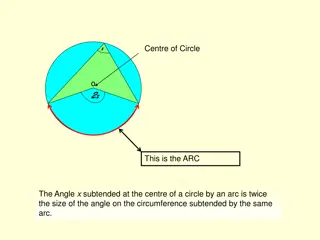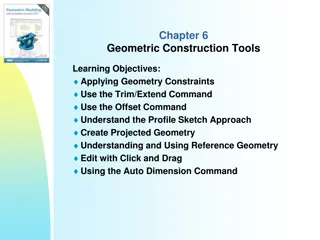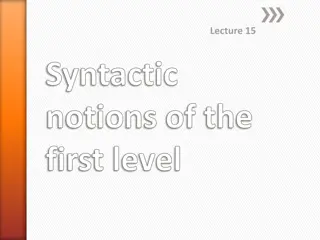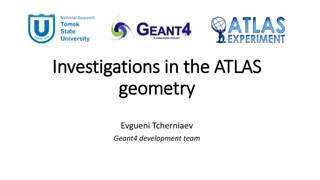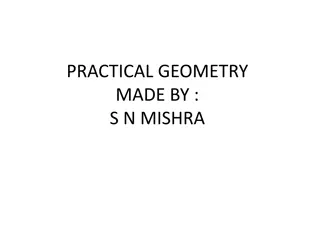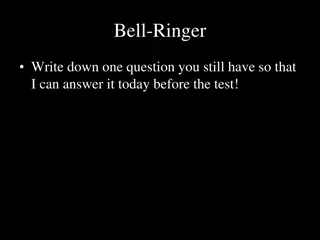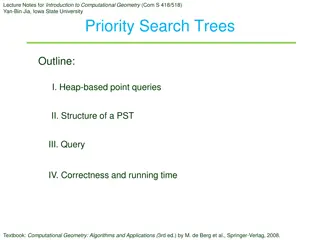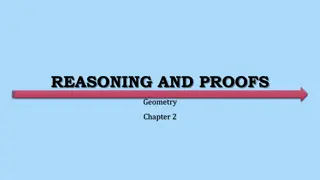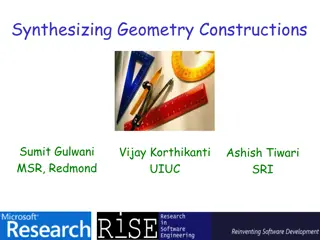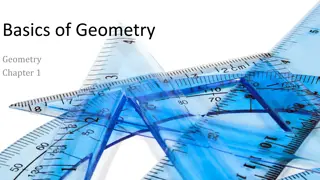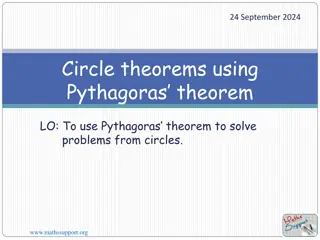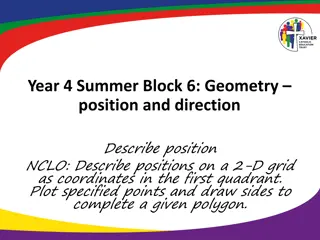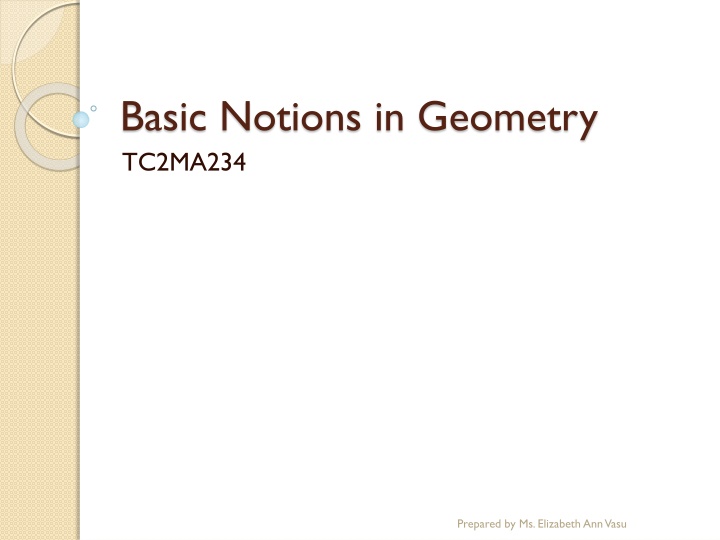
Exploring Basic Notions in Geometry with Ms. Elizabeth Ann Vasu
Discover the foundations of geometry, tracing back to the Greeks and Euclid over 2000 years ago. Explore key geometric elements such as points, lines, planes, rays, and line segments, with clear explanations and visual representations provided by Ms. Elizabeth Ann Vasu.
Download Presentation

Please find below an Image/Link to download the presentation.
The content on the website is provided AS IS for your information and personal use only. It may not be sold, licensed, or shared on other websites without obtaining consent from the author. If you encounter any issues during the download, it is possible that the publisher has removed the file from their server.
You are allowed to download the files provided on this website for personal or commercial use, subject to the condition that they are used lawfully. All files are the property of their respective owners.
The content on the website is provided AS IS for your information and personal use only. It may not be sold, licensed, or shared on other websites without obtaining consent from the author.
E N D
Presentation Transcript
Basic Notions in Geometry TC2MA234 Prepared by Ms. Elizabeth Ann Vasu
Geometry The word geometry comes from Greek words meaning to measure the Earth Basically, Geometry is the study of shapes and is one of the oldest branches of mathematics Prepared by Ms. Elizabeth Ann Vasu
The Greeks and Euclid Our modern understanding of geometry began with the Greeks over 2000 years ago. The Greeks felt the need to go beyond merely knowing certain facts to being able to prove why they were true. Around 350 B.C., Euclid of Alexandria wrote The Elements, in which he recorded systematically all that was known about Geometry at that time. Prepared by Ms. Elizabeth Ann Vasu
The Elements Knowing that you can t define everything and that you can t prove everything, Euclid began by stating three undefined terms: Point (Straight) Line is a line that lies evenly with the points on itself is that which has no part Plane (Surface) is a plane that lies evenly with the straight lines on itself Actually, Euclid did attempt to define these basic terms . . . Prepared by Ms. Elizabeth Ann Vasu
Point A point is a location in a plane or space. It is labeled point K. K Prepared by Ms. Elizabeth Ann Vasu
Line A line extends forever in both directions. A line is labeled with two arrows on the ends and written as AB. B A Prepared by Ms. Elizabeth Ann Vasu
Plane A Plane is a flat surface of any shape that can go on forever. Plane Plane
Ray A ray has one endpoint and the other is like a line, extending indefinitely. This means one point and one arrow. A ray is labeled as DC. D C
Line Segment A line segment has two endpoints, making it a definite length. It can be labeled as GH. G H
Vocabulary review: Identify the figure Plane: 2-dimensional space Line: Straight line that extends forever in both directions. Point:A spot on a line Ray: Starts at one point & extends forever in ONE direction Line Segment: Part of a line that is between two points point line ray The Plane line segment
Naming Rays Lines and Segments RS PQ ST PR RT Lines: Rays: Line Segments: MN NM
Match the term with the figure A. Ray B. Line C. Line Segment 1) 2) R 3) P Q S B A B C A
Exercise 1 What is another way to name line l ? Prepared by Ms. Elizabeth Ann Vasu
VERTICAL LINE A VERTICAL LINE goes up & down The candy bars are vertical
HORIZONTAL LINE A HORIZONTAL LINE goes across (left and right) The candy bars are Horizontal
Opposite Rays If a point B lies on AC between A and B, then BA and BC are opposite rays Prepared by Ms. Elizabeth Ann Vasu
Collinear Points Collinear points are points on the same line. D When, A, B and C are three collinear points, then B is between A and C if AB + BC = AC. Point D is not between A and C. Prepared by Ms. Elizabeth Ann Vasu
Exercise 1. If AB = 27 and BC = 13, find AC. Prepared by Ms. Elizabeth Ann Vasu
Exercise: 1. If RE = 4x + 7, ET = 2(3x 4) and RT = 43, then find the value of x, RE and ET. Prepared by Ms. Elizabeth Ann Vasu
Coplanar Points Coplanar points are points on the same plane. Points O, P, Q are coplanar points. Prepared by Ms. Elizabeth Ann Vasu
Exercise 2 1. Name three collinear points. 2. Name four coplanar points Prepared by Ms. Elizabeth Ann Vasu
Congruent Lines Segments Line segments that have the same length are called congruent line segments. AB = EF ( lengths are equal) AB EF ( is congruent to) Prepared by Ms. Elizabeth Ann Vasu
Exercise 1. If AB CD, AB = 2x 5 and CD = 7x 55, find AB. Prepared by Ms. Elizabeth Ann Vasu
Exercise 1. Given that ABCD is a line with AB CD, prove that AC BD Prepared by Ms. Elizabeth Ann Vasu
Non-coplanar Points Non-coplanar points are points that cannot all be placed on a single plane. Points O, P, Q and R are non-coplanar points. Prepared by Ms. Elizabeth Ann Vasu
Coplanar Lines Lines in the same plane are called coplanar lines. Lines OQ, QR and OR are coplanar. Lines OQ and PQ are coplanar. Prepared by Ms. Elizabeth Ann Vasu
Intersecting lines They are line with exactly one point in common. Lines AB and CD intersect at point E. Prepared by Ms. Elizabeth Ann Vasu
Skew Lines Lines for which there is no plane that contains them (they are not coplanar lines) Lines PQ and OR are skew lines. Prepared by Ms. Elizabeth Ann Vasu
Concurrent lines Three or more lines that intersect at the same point. Lines PQ, OQ and RQ are concurrent lines A set of concurrent lines. Prepared by Ms. Elizabeth Ann Vasu
Parallel lines Two coplanar lines are parallel if they do not intersect, or if they are the same line. A line is parallel to itself. m n Line m is parallel to n, written m||n; also m||m and n||n Prepared by Ms. Elizabeth Ann Vasu
Exercise 1. Name the intersection of PQ and line k. 2. Name the intersection of plane A and plane B. 3. Name the intersection of line k and plane A. Prepared by Ms. Elizabeth Ann Vasu
Exercise: 1. Sketch a plane and a line that is in the plane. 2. Sketch a plane and a line that does not intersect the plane. 3. Sketch a plane and a line that intersects the plane. Prepared by Ms. Elizabeth Ann Vasu
Axioms and Theorems Euclid considered geometric statements concerning points, lines, circles and planes. Some statements he called axioms/postulates, statements that could not be proven. Others that could be proven he called theorems. Prepared by Ms. Elizabeth Ann Vasu
Axioms 1. There is exactly one line that contains any two distinct points. 2. If two points lie on a plane, then the line containing the points lie in the plane. 3. If two distinct planes intersect, then their intersection is a line. 4. There is exactly one plane that contains any three distinct non-collinear points Prepared by Ms. Elizabeth Ann Vasu
Axioms 5. Through any two points one and only one line can be drawn. 6. Two lines cannot intersect in more than one point. 7. The shortest distance between any two points is the line segment joining them. 8. A line segment has only one mid-point. Prepared by Ms. Elizabeth Ann Vasu
Exercise: 1. If two distinct lines AEB and CED intersect at a point F, what must be true about point E and F? Use the above axioms to justify your answer. Prepared by Ms. Elizabeth Ann Vasu
Exercise: If CE = CF, CD = 2CE and CB = 2CF, then prove that CD = CB. Prepared by Ms. Elizabeth Ann Vasu
Theorems 1. A line and a point not on the line determine a unique plane. 2. Two distinct parallel lines determine a unique plane. 3. Two distinct intersecting lines determine a unique plane. Prepared by Ms. Elizabeth Ann Vasu

